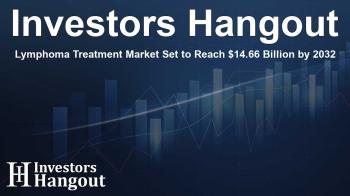Lymphoma Treatment Market Set to Reach $14.66 Billion by 2032

Overview of the Lymphoma Treatment Market Growth
The lymphoma treatment market is experiencing significant growth, projected to reach USD 14.66 billion by 2032, up from USD 7.01 billion in 2023. This represents a remarkable compound annual growth rate (CAGR) of 8.54% over the forecast period from 2024 to 2032. As the prevalence of Hodgkin and non-Hodgkin lymphoma rises, combined with advancements in immunotherapy, the sector is poised for expansion.
Key Drivers of Market Growth
Several factors are driving growth within the lymphoma treatment market. Noteworthy among these is the increased rate of lymphoma diagnoses, highlighting a pressing public health need. In parallel, the trend towards immunotherapy is reshaping treatment modalities, showcasing promising outcomes in many patients. Additionally, substantial investments in research and development are further enhancing treatment options, especially focusing on CAR-T therapies and other innovative drug developments.
The Role of Immunotherapies
Immunotherapy, encompassing antibody therapies and CAR-T cell treatments, has emerged as a vital component of contemporary lymphoma management. These therapies leverage the body's immune system to combat cancer cells, often resulting in improved efficacy and reduced side effects. Consequently, this innovative approach is attracting significant interest from healthcare providers and researchers alike.
Technological Advances and Patient Awareness
The proliferation of advanced diagnostic technologies and heightened awareness among both patients and healthcare practitioners are pivotal to the market's expansion. Enhanced screening capabilities have led to earlier detection rates, thereby influencing treatment outcomes positively. Moreover, as the medical community better understands lymphoma dynamics, treatment protocols continue to evolve, paving the way for targeted therapies that are specific to patient needs.
Market Segmentation Insights
Non-Hodgkin lymphoma (NHL) accounts for the largest segment of the lymphoma treatment market, capturing an estimated 85.54% of total market share in 2023. This prevalence can be attributed to the multitude of NHL subtypes, which necessitate complex and multifaceted treatment strategies. These may involve chemotherapy, immunotherapy, and other targeted therapy methodologies.
Leading Drugs in the Market
The drug segment is dominated by MabThera (Rituxan), which held a significant 22% share. Recognized as one of the first-line treatments for various NHL indications, this CD20-targeting monoclonal antibody demonstrates substantial efficacy, particularly when combined with chemotherapy. Its widespread acceptance in clinical protocols underscores its pivotal role in lymphoma therapies.
Distribution Channels and Healthcare Infrastructure
Within the lymphoma treatment framework, hospital pharmacies play a crucial role, holding a 37% share of distribution channels. Hospitals serve as primary facilities for complex and specialized care, especially for oncology treatments that demand meticulous monitoring, such as immunotherapies and CAR-T cell therapies. This positioning is further supported by the robust healthcare infrastructure in regions like North America, particularly the U.S.
Regional Market Dynamics
North America remains the dominant player in the lymphoma treatment market, boasting a 52% market share in 2023. This dominance is fueled by a mature healthcare ecosystem, a strong presence of leading pharmaceutical companies, and favorable reimbursement policies. Moreover, ongoing clinical research initiatives and regulatory support from agencies like the FDA are accelerating the approval of new therapies.
Emerging Trends in Asia-Pacific
Conversely, the Asia-Pacific region is expected to demonstrate the highest growth rate in the lymphoma treatment market during the forecast period. Governments in countries like China and India are investing heavily in healthcare infrastructure and biotech innovations. This commitment has led to enhanced access to cancer care, increased awareness, and improved diagnosis rates, which further drive treatment adoption.
Summary and Conclusion
The lymphoma treatment market presents a robust growth trajectory, bolstered by advancements in immunotherapy and the increasing prevalence of lymphoma cases globally. As companies innovate and develop more effective therapies, coupled with supportive healthcare policies, the market landscape is likely to evolve, ensuring better patient outcomes and enriched treatment paradigms.
Frequently Asked Questions
What is the current value of the lymphoma treatment market?
As of 2023, the lymphoma treatment market is valued at USD 7.01 billion.
What is the projected market size by 2032?
The market is projected to reach USD 14.66 billion by 2032.
What is driving the growth of the lymphoma treatment market?
The growth is fueled by the increasing prevalence of lymphoma, advancements in immunotherapy, and substantial R&D investments.
Which drug holds the largest market share in lymphoma treatments?
MabThera (Rituxan) is the leading drug in the market, commanding a significant share due to its effectiveness as a first-line treatment.
How does the Asia-Pacific region contribute to this market?
The Asia-Pacific region is anticipated to register the highest growth due to enhanced investment in healthcare infrastructure and increased disease awareness.
About The Author
Contact Addison Perry privately here. Or send an email with ATTN: Addison Perry as the subject to contact@investorshangout.com.
About Investors Hangout
Investors Hangout is a leading online stock forum for financial discussion and learning, offering a wide range of free tools and resources. It draws in traders of all levels, who exchange market knowledge, investigate trading tactics, and keep an eye on industry developments in real time. Featuring financial articles, stock message boards, quotes, charts, company profiles, and live news updates. Through cooperative learning and a wealth of informational resources, it helps users from novices creating their first portfolios to experts honing their techniques. Join Investors Hangout today: https://investorshangout.com/
The content of this article is based on factual, publicly available information and does not represent legal, financial, or investment advice. Investors Hangout does not offer financial advice, and the author is not a licensed financial advisor. Consult a qualified advisor before making any financial or investment decisions based on this article. This article should not be considered advice to purchase, sell, or hold any securities or other investments. If any of the material provided here is inaccurate, please contact us for corrections.

